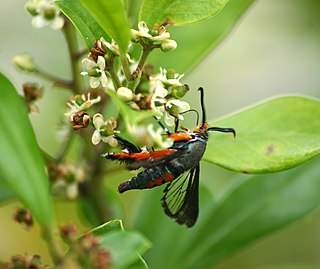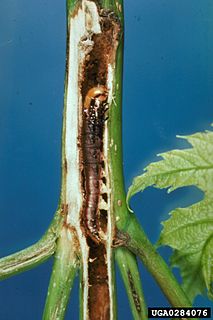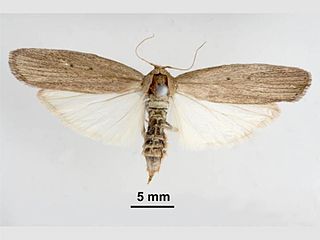
The Tortricidae are a family of moths, commonly known as tortrix moths or leafroller moths, in the order Lepidoptera. This large family has over 11,000 species described, and is the sole member of the superfamily Tortricoidea, although the genus Heliocosma is sometimes placed within this superfamily. Many of these are economically important pests. Olethreutidae is a junior synonym. The typical resting posture is with the wings folded back, producing a rather rounded profile.

The Crambidae are the grass moth family of lepidopterans. They are variable in appearance, the nominal subfamily Crambinae taking up closely folded postures on grass stems where they are inconspicuous, while other subfamilies include brightly coloured and patterned insects which rest in wing-spread attitudes.

The Pyralidae, commonly called pyralid moths, snout moths or grass moths, are a family of Lepidoptera in the ditrysian superfamily Pyraloidea. In many classifications, the grass moths (Crambidae) are included in the Pyralidae as a subfamily, making the combined group one of the largest families in the Lepidoptera. The latest review by Eugene G. Munroe and Maria Alma Solis retain the Crambidae as a full family of Pyraloidea.

Ceratomia amyntor, the elm sphinx or four-horned sphinx, is a North American moth in the family Sphingidae. The species was first described by Carl Geyer in 1835. It has a wingspan of 3+1⁄4-4+1⁄2 inches. As the name suggests, the larvae (caterpillars) feed on elm trees (Ulmus), but they can also be found feeding on birch (Betula), basswood (Tilia), and cherry (Prunus). When the caterpillars are ready, they crawl to the bottom of the host tree, where they crawl underneath the soil and pupate and may overwinter underground if late enough into the year. Vegetable growers should be aware of this larvae due to its insatiable appetite. One of these larvae are capable in devouring huge amounts of plant's foliage and even succulent stems.

The squash vine borer is a diurnal species of sesiid moth. It is native to North America. The moth is often mistaken for a bee or wasp because of its movements, and the bright orange hind leg scales. The females typically lay their eggs at the base of leaf stalks, and the caterpillars develop and feed inside the stalk, eventually killing the leaf. They soon migrate to the main stem, and with enough feeding damage to the stem, the entire plant may die. For this reason, it is considered a pest that attacks cultivated varieties of squash, zucchini, pumpkin, and acorn squash. The squash vine borer is native to North America. It lives in most temperate North American states, except the Pacific coast. Southern states have two broods a year.

The stalk borer is a moth of the family Noctuidae. It is found from southern Canada, through the Eastern United States to the Gulf of Mexico, although it is absent from Florida.
Hellula phidilealis, the cabbage budworm moth, is a moth of the family Crambidae. It is found in tropical and subtropical America. From the southern United States, north in the east to North Carolina, south through southwestern Mexico to northern South America, including several islands in the Caribbean.

Eldana is a genus of moths of the family Pyralidae containing only one species, the African sugar-cane borer, which is commonly found in Equatorial Guinea, Ghana, Mozambique, Sierra Leone and South Africa. Adults have pale brown forewings with two small spots in the centre and light brown hindwings, and they have a wingspan of 35mm. This species is particularly relevant to humans because the larvae are a pest of the Saccharum species as well as several grain crops such as sorghum and maize. Other recorded host plants are cassava, rice and Cyperus species. When attacking these crops, E. saccharina bores into the stems of their host plant, causing severe damage to the crop. This behavior is the origin of the E. saccharrina's common name, the African sugar-cane borer. The African sugar-cane borer is a resilient pest, as it can survive crop burnings. Other methods such as intercropping and parasitic wasps have been employed to prevent further damage to crops.
Buckleria parvulus, the sundew plume moth, is a moth of the family Pterophoridae. The species was first described by William Barnes and Arthur Ward Lindsey in 1965 from Archbold Biological Station, Florida. It is found in the south-eastern United States, including Florida, North Carolina, Louisiana, Alabama, Georgia, Mississippi, South Carolina and Texas.

Ipomoea lacunosa, the whitestar, white morning-glory or pitted morning-glory, is a species that belongs to the genus Ipomoea. In this genus most members are commonly referred to as "morning glories". The name for the genus, Ipomoea, has root in the Greek words ips and homoios, which translates to worm-like. This is a reference to the plant's vine-like growth. Lacunosa comes from a Latin word meaning air spaces, correlating with the venation of the leaves. Ipomoea lacunosa is native to the United States and grows annually. The flowers of this species are usually white and smaller than most other morning glories.

Chilo plejadellus, the rice stalk borer moth, is a moth in the family Crambidae described by Johann Leopold Theodor Friedrich Zincken in 1821. It is found in North America, including Illinois, Ontario, Quebec, Pennsylvania, Georgia, Louisiana, Wisconsin, Texas and Arkansas.

Depressaria daucella is a moth of the family Depressariidae. It is found in most of Europe, except most of the Balkan Peninsula. It is also found in North America.

Scirpophaga incertulas, the yellow stem borer or rice yellow stem borer, is a species of moth of the family Crambidae. It was described by Francis Walker in 1863. It is found in Afghanistan, Nepal, north-eastern India, Sri Lanka, Bangladesh, Myanmar, Vietnam, Thailand, Malaysia, Singapore, Sumatra, Java, Borneo, Sumba, Sulawesi, the Philippines, Taiwan, China and Japan.
Chilo agamemnon is a species of moth in the family Crambidae described by Stanisław Błeszyński in 1962. It is found in Spain, Egypt, Israel, Sudan and Uganda.
Prodoxus atascosanellus is a moth of the family Prodoxidae. It is found from the Houston area of coastal Texas in the United States, south to the Mexican state of Michoacán, and west to the state of Durango.

Argyresthia oreasella, the cherry shoot borer moth, is a moth of the family Yponomeutidae. It is found in North America, including New York, Michigan, Idaho, Missouri, Colorado, New Mexico, California, Quebec, Alberta and Saskatchewan.
Sesamia cretica, the corn stem borer, greater sugarcane borer, sorghum stem borer, stem corn borer, durra stem borer, large corn borer, pink sugarcane borer, sugarcane pink borer, sorghum borer, pink corn borer, maize borer or purple stem borer, is a moth of the family Noctuidae. It was described by Julius Lederer in 1857. It is found in most of the countries and islands of the Mediterranean basin. The range extends through the Middle East and Arabia to Pakistan, northern India and northern Africa. In the south, the range extends to northern Kenya and northern Cameroon.

Phalonidia affinitana, the large saltmarsh conch or large saltmarsh bell, is a species of moth of the family Tortricidae, the subfamily Tortricinae, and the tribe Cochylini. It is found in China, Japan, Korea, Russia and most of Europe. Its habitat consists of salt marshes.

Virbia laeta, the joyful holomelina, is a moth in the family Erebidae. It was described by Félix Édouard Guérin-Méneville in 1844. It is found in North America from New Brunswick south to Florida and west to Minnesota and south to Texas. The habitat consists of pine woodlands.

Maguey worms, are one of two species of edible caterpillars that infest maguey and Agave tequilana plants.














